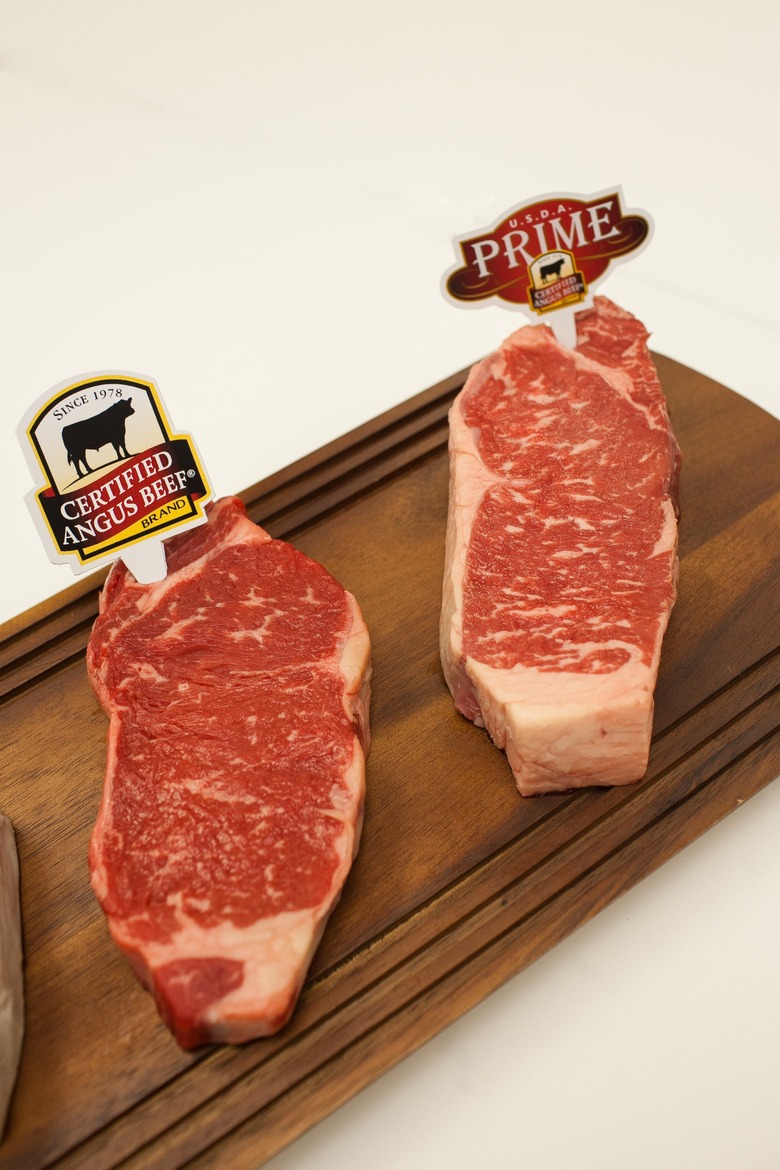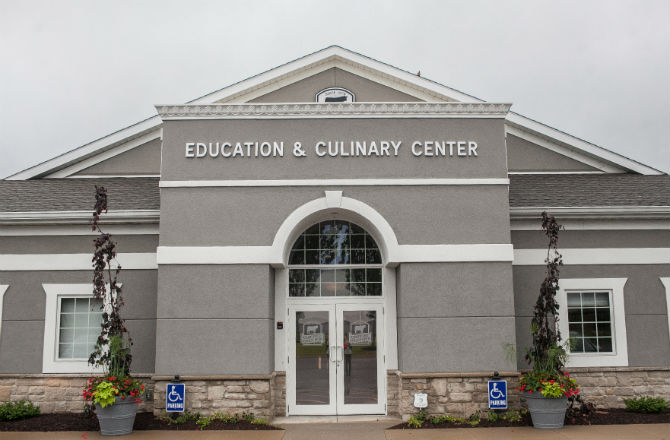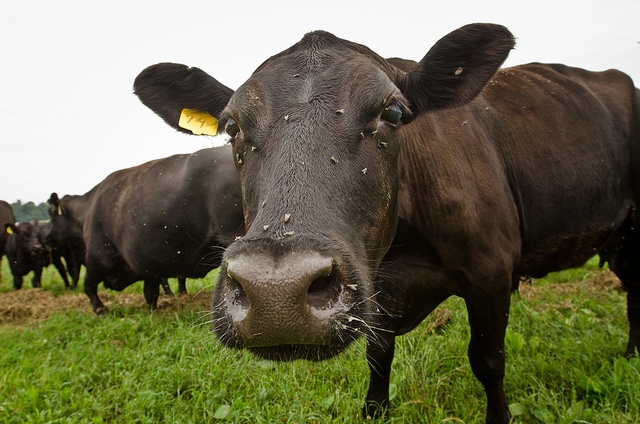The Creative Culinary Minds Behind Certified Angus Beef
You may have noticed Certified Angus Beef (CAB) labels on packages of meat at the supermarket, or perhaps you saw the name mentioned on menus at fancy steakhouses. But odds are, those words never communicated their intended meaning, nor did they convey what makes Certified Angus Beef such a special trademark.
Until this summer, I had no idea myself, but a trip to CAB's Education and Culinary Center at its headquarters in rural Wooster, Ohio got me thinking about beef a bit differently.
As a chef and food writer whose family worked in meat distribution, I was intrigued by the opportunity to meet with CAB's meat scientist, Dr. Phil Bass, Ph.D., to talk about what makes Certified Angus Beef better than store-brand stuff (which, you may have heard, is pretty nasty, with some stores using a substance dubbed "pink slime" in their grinds). I was also psyched to meet the culinary team working with Dr. Bass to raise awareness about the brand, especially since I'd heard that one of CAB's chefs used to cook for a royal family.
But first, to give you an idea of CAB's purpose, let's do a lightning-fast lesson on the United States Department of Agriculture's (USDA's) beef quality grades, because that's essential to understanding its industry role.
USDA inspectors award grades to cattle carcasses based on factors such as age, fat ratio, and "marbling," or intramuscular fat — that is, fat within the meat, not around it — which is responsible for giving certain cuts of beef that magical quality where nothing more than a sprinkle of salt is needed to unleash a tsunami of umami.
The best grade is "Prime," followed in descending order by "Choice" and "Select" to round out the top three.
After that, things get dicey.
Following "Select," there's "Standard" and "Commercial," which "are frequently sold as ungraded or as 'store brand' meat" (hello, pink slime!), followed by "Utility," "Cutter," and the oh-so-appetizingly-named "Canner," which "are seldom, if ever, sold at retail but are used instead to make ground beef and processed products," according to the government's website.
(The USDA is looking into revising these standards.)
If you already knew any of that, then you deserve serious applause.
So, you're wondering, where does the "Angus" thing come into play?
Angus is a breed of cattle, and it happens to be one of the most popular breeds for beef because of its superb marbling. You may have heard of "Black Angus," but that's borderline redundant, as most Angus cattle are black.
But not all Angus cattle are created equal.
That becomes a problem when the Angus name itself is capable of yielding unmerited distinction.
This situation arose in the 1970s when an Ohio-based Angus rancher named Harold Etling had an unpleasant restaurant experience with steak that was allegedly Angus. It was memorable for all the wrong reasons.
Disgusted, Etling knew he needed to protect people from being misled by the Angus name alone. He grouped with other Angus ranchers in the area, determined to bring a product to market for discerning customers who could appreciate a superior slab. With backing from the American Angus Association, CAB was formed in 1978, and established its own set of quality standards to determine whether an Angus carcass could be labeled "Certified Angus Beef."
CAB's 10 standards are science-based and differ from the standards employed by the USDA's quality grading system, although the same USDA inspectors check Angus cattle for CAB's standards. In just 1.5 percent of inspections, beef will meet the requirements to be labeled both USDA Prime and Certified Angus Beef, which offers the ultimate Angus experience.
A nonprofit, CAB owns no cattle or farmland. Instead, it works with Angus ranchers as a marketing arm and earns pennies on the dollar for every pound of CAB product sold. But when about 900 million pounds are being sold across nearly 50 nations each year, that's more than enough to assemble an all-star culinary team to help CAB grow.
Now that you know about the organization, let's meet the chefs (and the meat scientist) who are helping to make Certified Angus Beef a household name.
Chef Tony Biggs — Director of Culinary Arts
Cooking full-time for a king and queen would be a gig no chef would willingly trade, right? Sure, if we were talking about most chefs. But chef Tony Biggs doesn't don your typical toque.
Biggs understands that any cooking gig — royal or not — can get old after a while, which is why he ditched King Abdullah II's royal palace in Amman, Jordan, for the kitchen at CAB's Education and Culinary Center in small-town Wooster, Mass.
And it's a move he hardly regrets.
As Director of Culinary Arts, Biggs brings worldly experience and gastronomic expertise (which includes stints at hotels and restaurants in Massachusetts, Puerto Rico, and Tokyo, as well as working for the Second Harvest Food Bank in New Orleans after Hurricane Katrina) to CAB, where he develops gourmet recipes, cooks for VIP guests, and spearheads initiatives to educate chefs, customers and purveyors how to get the most out of Certified Angus Beef.
Chef Michael Ollier — Corporate Chef
A former newspaper columnist and food photographer, Chef Ollier comes from a family of culinarians and butchers. He began as sous chef for Parker Bosley, a major player in the Ohio culinary scene, and worked his way to the prestigious Ecole Lenôtre for training in Paris after winning a writing grant from the International Association of Culinary Professionals (IACP).
Ollier represents the brand on TV and radio, and he is responsible for much of the organization's food styling.
Chef Ashley Pado — Chef and Food Stylist
Chef Pado is the young-gun of the group, bringing passion, creativity, and classical Le Cordon Bleu training into the mix. Pado received her culinary arts degree in California, and worked with celebrities in L.A. before opting for a more laid-back lifestyle in Wooster.
You can catch her representing CAB and kicking butt on Food Network's Cutthroat Kitchen in early 2015.
Dr. Phil Bass, Ph.D. — Meat Scientist
Dr. Bass (who typically goes by Dr. Phil for comedic purposes) was raised on a cattle farm in Northern California, and "grew up cutting meat as soon as [he] was tall enough to reach the table in [his] grandmother's garage."
When his butcher's coat isn't covered in a Jackson Pollack of blood and bovine fluids, he's passionately educating people on the scientific merits of Certified Angus Beef, like how its 80/20 ground beef has exponentially more flavor than "store brand" stuff because of the type of fat used in the grind. Cheap, flavorless backfat is the filler of choice with the economy meat, whereas CAB grinds use naturally marbled cuts, like brisket, which makes it juicy and full of flavor.
Dr. Bass received his doctorate from Colorado State University, and is now an affiliate faculty member in its animal sciences department.
If you're looking to become more educated about beef, check out Dr. Bass' highly informative and entertaining videos on YouTube, where he explains everything from marbling to the specs used in determining which Angus carcasses make the CAB cut.




